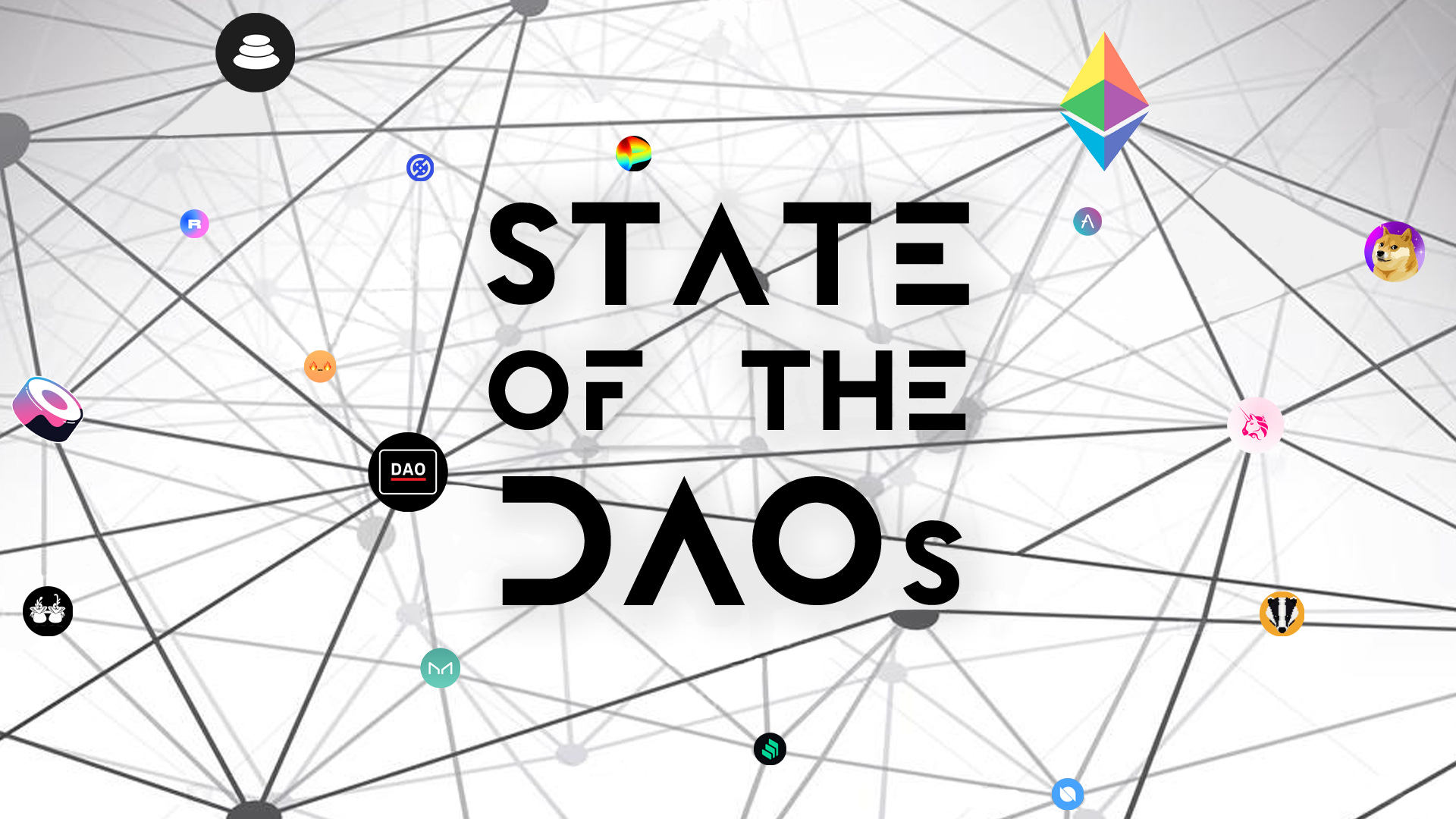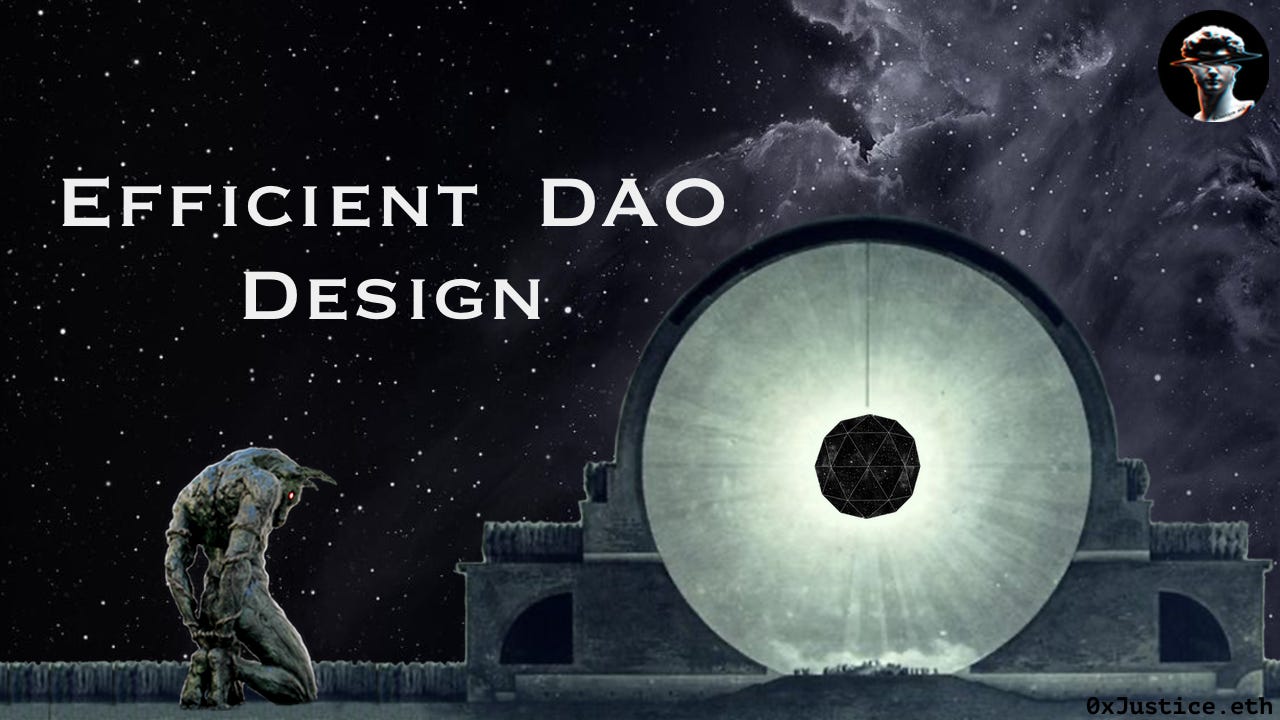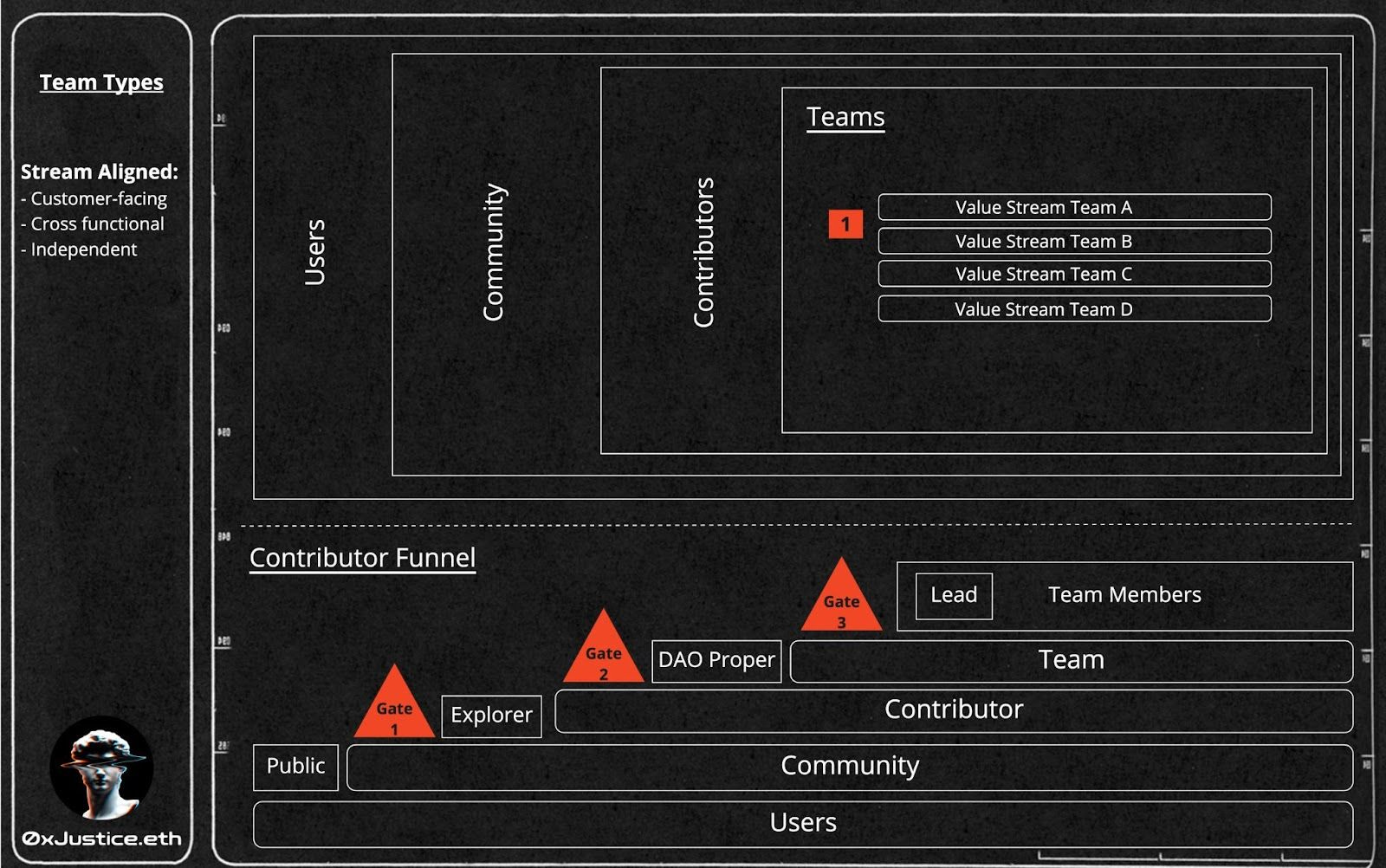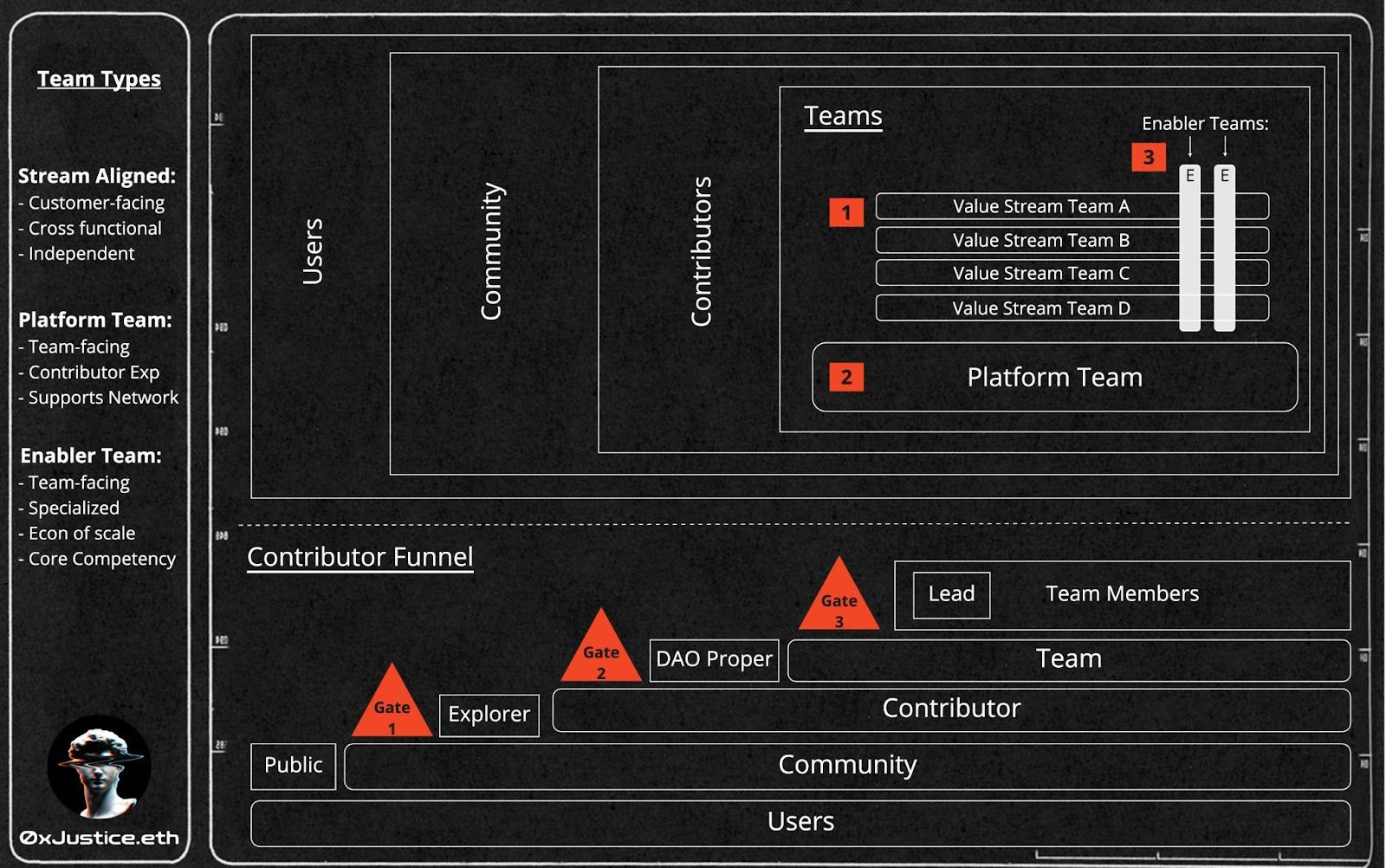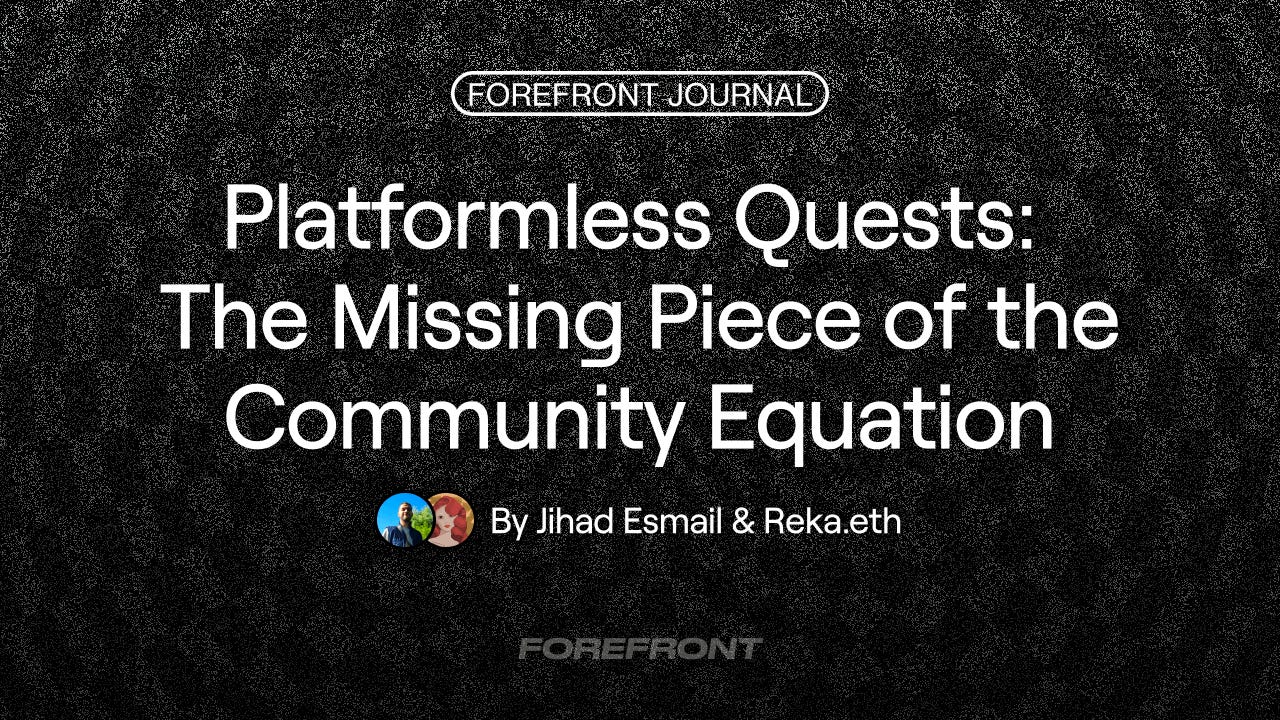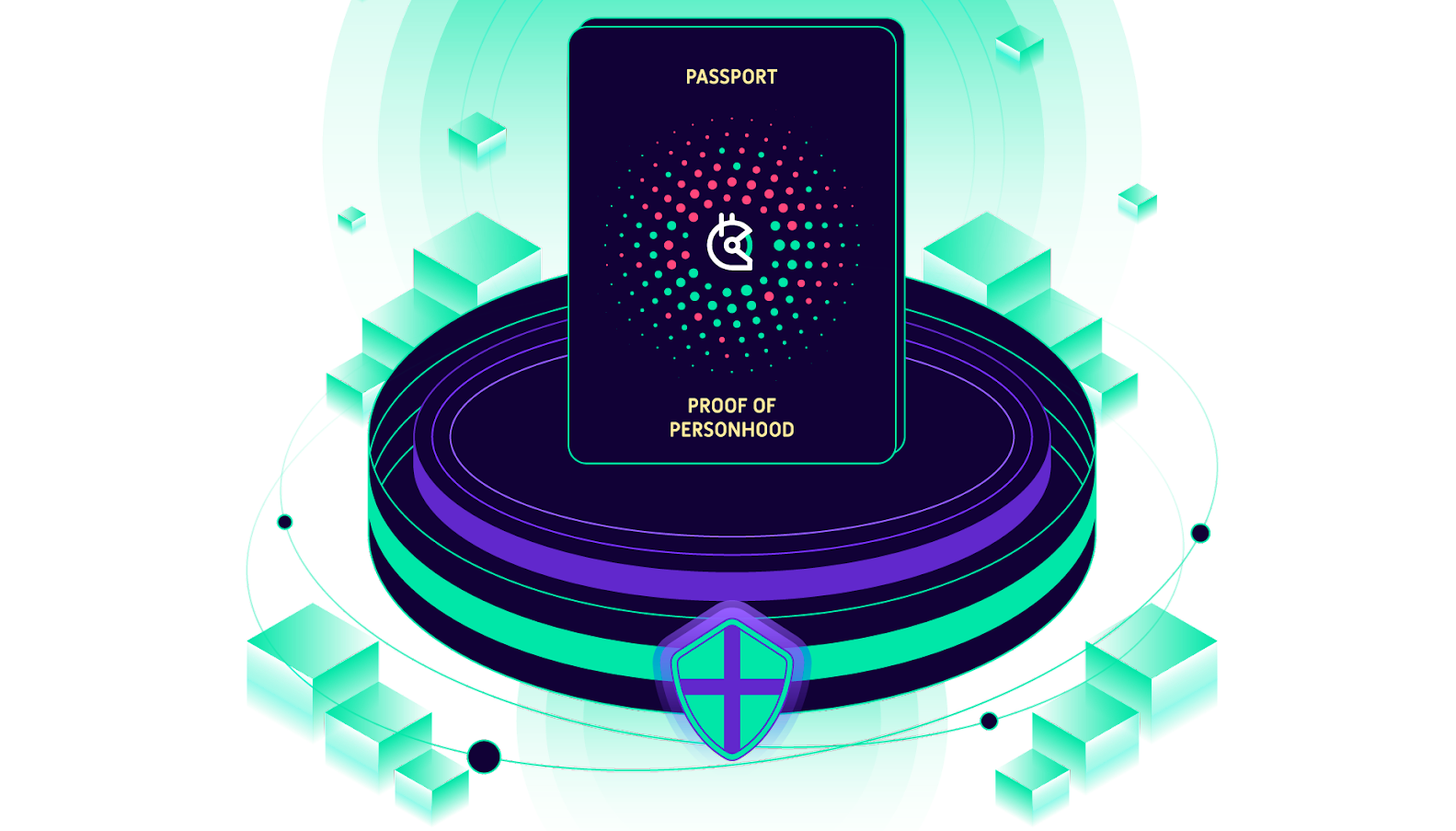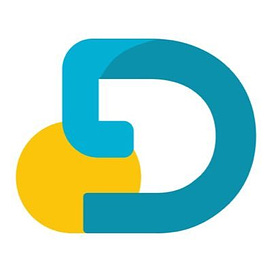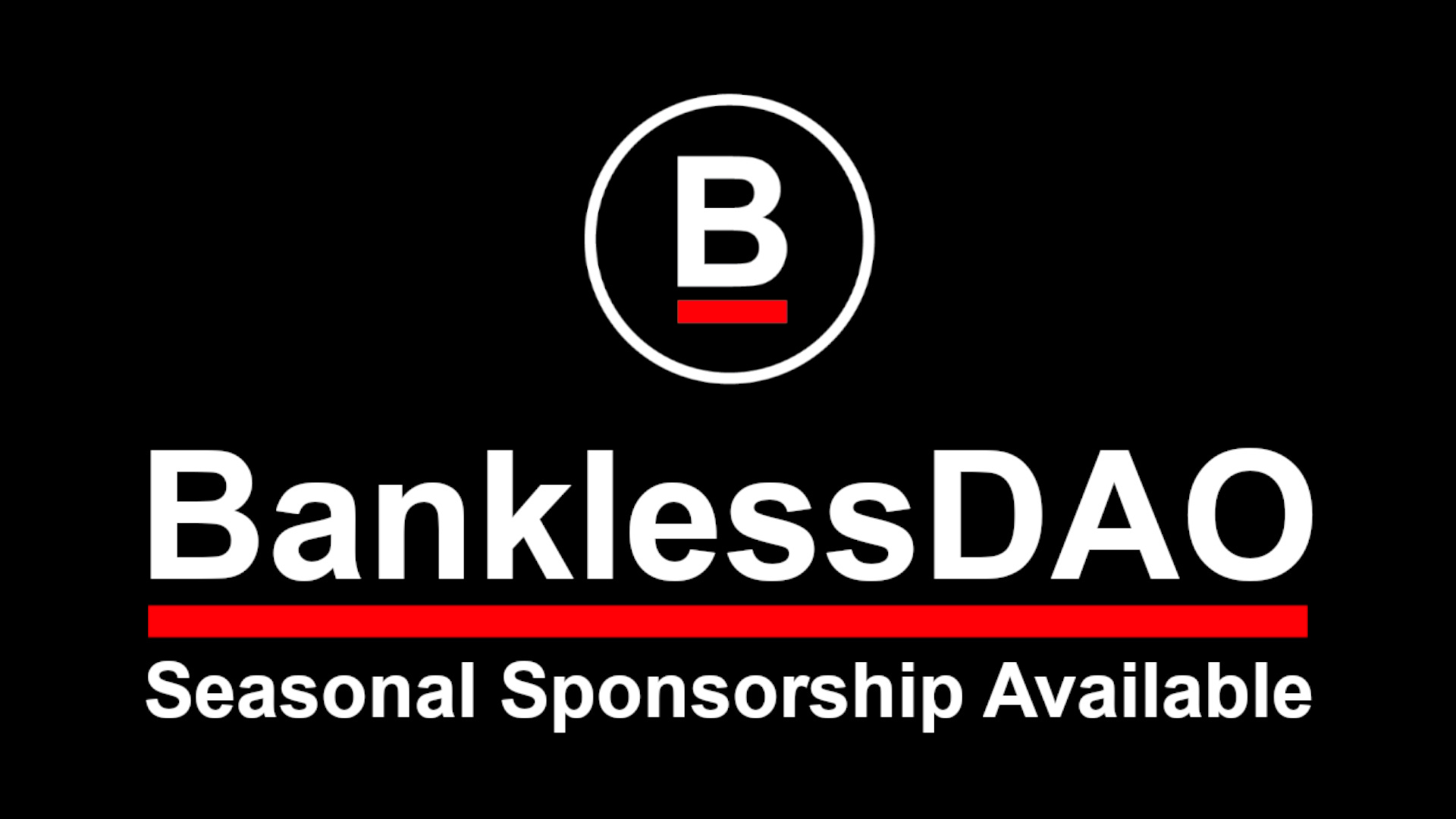Bankless DAO - DAO Efficiency
DAO EfficiencyYou're reading State of the DAOs, the high-signal low-noise newsletter for understanding DAOs.
gm gm and welcome to the State of the DAOs! Today, DAOs need architects as much as they need operators. In order for DAOs to be effective, we need structure and much of this structure can come from the existing world. Decentralization is not orthogonal to efficiency. In fact, decentralization is the only way to create an ecosystem of components that are good at what they do. Today, 0xJustice dives into how to organize a DAO. Afterwards, Seneca52 demonstrates how DAOs can be more effective than traditional non-profits. Seneca52 interviews Kris of Gitcoin and Madison of DreamDAO about the insights on structure and simplicity that these DAOs have uncovered. Finally, we share the TL;DR on the latest DAO ecosystem takes and thought pieces, making it easy for you to cut through the noise and stay up to date on the world of DAOs. This is the current state of the DAOs. Contributors: BanklessDAO Writers Guild (0xJustice, Seneca52, Alvo von A, Austin Foss, Ashpreet, Suyash, hirokennelly, siddhearta, Jake and Stake) This is the official newsletter of BanklessDAO. To unsubscribe, edit your settings. Efficient DAO DesignAuthor: 0xJustice.eth Support the Author: Buy the NFT DAO Operators are feeling the pain of coordination, communication, and execution failure. Is this the future we have envisioned? Are we really on the path to constructing new Digital Nations? Many veteran operators have even stated that the DAO construct is intrinsically inefficient. I have good news for you: Decentralization is not only compatible with efficient execution; it requires it. The bad news is that efficiency doesn't come for free. It must be injected through careful organizational design. In this article, we'll unpack these claims and their implications. We’ll then review a possible inspiration for such a design and try to apply it all in a DAO context. The Properties of Efficient DesignEfficiency is DecentralizedDecentralization is necessary for maximum efficiency. We can deduce this truth from multiple independent spheres of science. In cybernetics, the Conant-Ashby Theorem states that every system regulator must have an internal model of the system it regulates. A natural consequence of this is the darkness principle, which states that each element in a system is necessarily ignorant of the system's behavior as a whole. The academic response to both observations has been to admit that self-organizing systems must delegate control to subsystems closer to the information needed for control. Distributed control is required for complex adaptive systems to work. In economics, the Local Knowledge Problem is the observation that the data required for rational economic planning is distributed among individual actors and thus unavoidably exists outside the knowledge of a central authority. Again, we are stuck in unavoidable ignorance if we try to control a system of free agents centrally. Here too, efficiency requires the adoption of decentralized decision-making. Political philosophy has the Subsidiarity Principle. This principle argues that the smallest, lowest, and least centralized political authority should handle as many matters as possible. A central authority should have a subsidiary function performing only those tasks that more immediate local levels cannot. All of the above concepts communicate the same message. They all speak to the idea that individuals closest to a problem should make the decisions. This principle is a core axiom of sociotechnical design, which argues that the final design of work systems must be done by those who do the work. Otherwise, they fail to account for crucial system components often unseen by those not directly involved at that level. Decentralization isn't one way of doing things — it's the only way in complex adaptive systems. It's the edge computing of efficiency. Efficiency Must be DesignedEfficiency is the result of careful org design. This is implied by the very term “organization” and a consequence of the Theory of the Firm and Conway's Law. The premise is that individuals must organize themselves, their interactions, and their outputs to produce complex and desirable goods. This is hard, yet many DAOs expect to grow into efficiency simply by virtue of being decentralized. Productive efficiency is not emergent. The only things we get for free are entropy, coordination failure, and the tragedy of the commons. As Web3 thinkers frequently compare DAOs to biological organisms, it's tempting to assume that optimum structures and flows will emerge by themselves through a kind of Darwinian emergence. This natural selection may be valid for the ecosystem but not for any particular DAO. The treasury will empty faster than you can cycle through every possible combination of organizational design. The Moloch meme rests on the premise that we can slay coordination failure through intelligent engineering, not that it happens automagically. Design is Often Componentized (and even Hierarchical!)Efficient design is often layered, specialized, and sometimes even hierarchical. The meme of DAOs destroying all hierarchy may be too strong and appealing to qualify with nuance. But the inescapable reality is that great design is often hierarchical. This is natural and not merely the product of human social dynamics. We can use alternative terms like namespace, scope, and abstraction to communicate the same concept—specialized and layered responsibility. Orgs need scoped concerns to reduce cognitive load and coordination overhead. This fact doesn't equate to a command and control or dictatorial government. I mention this because we may be inadvertently short-circuiting our efforts at good design if we rule out this pattern from the outset. What's important is to avoid exploitative entities. Each abstraction level should increase, not extract value from the system. We must remember that the network is decentralized, not every individual or organizational unit that comprises it. Ignoring this is a trap and has been the death of many well-intentioned projects that never shipped because they got mired in premature and recursive decentralization efforts. Efficient Design InspirationThese design properties may give us insight, but what about real-world examples? I believe we can find them by looking at companies organized as Agile Networks. The Haier Corporation is one such example. Haier is a 35 billion dollar appliance company that has arranged itself into 4000 microenterprises (ME). Each ME is free to form and evolve with little central control and falls into one of three functional archetypes:
This structure works together to produce an incentive-aligned, customer-facing, decentralized platform. Let's look at each of the properties of this setup. Independently IncentivisedAt Haier, all MEs stand or fall by their own merits and are free to interact with each other however they see fit. The main business lines can pick another supply node if they fail to perform. If a business line goes out of business, its service nodes lose a customer. If an ME believes an external provider would better meet its needs, it can go outside for services. How does this relate to DAOs? Relying exclusively on a shared token is insufficient incentive alignment. Businesses don't grind and make sacrifices for the sake of a national currency. They do it to win for themselves, and if they cannot deliver, they cease to exist. We cannot exclude competition and the survival instinct without serious negative consequences. Without these incentives, teams will budget based on historical spending instead of anticipated investment returns. Customer FacingHaier predominantly orients organizational units around customer-facing lines of service. Everyone is directly accountable to their customers. Haier has a strict policy of not funding new lines of business until customers validate a product. Haier CEO, Zhang Ruimin, likes to say that they no longer pay their employees because they are instead paid directly by the customer. There is much we can learn from this. The DAO treasury is not the customer. The ultimate success metric for a DAO is not proposals asking for distributions but the number of launched products with paying customers resulting in treasury inflows and increased network value. We talk a lot about democracy in Web3, but one of the purest forms of democracy is the free market, where individuals vote with their resources. The customer's "vote" should be the ultimate priority. The dangerous alternative is a kind of Santa Clause economics where everyone votes yes to everyone's budget proposal because they want them to vote yes to their own. Decentralized PlatformHaier functions more like a network and launch platform than a singular corporation. Small autonomous teams make decisions, and Haier focuses on creating the optimum conditions for launching those teams. Ruimin describes this construction as "small pieces, loosely joined." This maxim is a well-known IT and organizational design pattern that DAOs should internalize. From this perspective, we can view DAOs as app stores and economies rather than mega Corps or monoliths. We can view them as networked incubators and not as individual businesses. This framing has massive ramifications for strategic prioritization because it allows us to focus on identifying any great opportunity and the project launch experience rather than a predefined product space.  One venture capitalist has described Haier as "a giant search function scanning the battlefield and identifying the most promising opportunities." DAOs can uniquely amplify this dynamic if we leverage them as launch platforms. See DAOs as novelty search engines. Applying Efficient Design to DAOsThese observations may be interesting, but how can they be implemented and applied to an already operational DAO? The good news is that this is not a challenge unique to DAOs. There's an established body of research called Team Topologies and a technique called an Inverse Conway Maneuver we can apply for our use. This approach and recommendations build on the premise that your organization's output will mirror your organizational configuration (Conway's Law) and that you can internally reorganize around a desired outcome to create greater efficiency. These illustrations build on my previous work detailed in Rethinking the DAO Contributor Funnel. The bottom half of the diagrams views the DAO from the side, while the top half views it from the top. We’ll be zooming in on the team area for what follows. Step 1: Solidify Existing Value StreamsIdentify how the DAO makes money, then independently incentivize those product teams proportional to their success. You can do this through a revenue split. What thing of value are you trying to produce? Organize around it. Is it a podcast? Organize around extended learning materials linked to episodes or by making other similarly themed shows .What is the quality of the launch experience? How is new talent sourced to existing value streams? If current value streams aren't making money, we must prepare the soil for future ones that will. Step 3: Introduce Enabler TeamsIntroduce enabler teams to provide commoditized services incentivized around the main workstreams. We distinguished the platform from the value streams in the last two steps. In this step, we identify opportunities for scale and address them through consolidated service teams. These could be web design, legal services, or social media management. This step acknowledges the reality of economies of scale and the principle of core competency. These service teams will free teams to do the unique thing they do well and not get weighed down by auxiliary concerns. All value streams greatly benefit from these commoditized internal services provided in scale-efficient ways. An enabler team that makes websites or sets up legal wrappers for incubated projects is of tremendous value. Step 4: Practice Timeboxed IterationsLastly, operate within multiple reporting, funding, shipping, and governance cycles. These should be weekly, bi-weekly, monthly, and quarterly iterations. No perfect structure exists; only ones fit for a time and context. This reality requires DAOs to be constantly evolving and experimenting. Establishing fast feedback loops and more opportunities to inspect and adapt is essential. Here again, we have Haier's CEO as an example. ".. it's impossible to engineer a complex system from the top down. It has to emerge through an iterative process of imagination, experimentation, and learning. When asked how Haier can accelerate its transformation, he has a simple answer: Run more trials and replicate the most successful ones faster because revolutionary goals are best achieved through evolutionary means." - Zhang Ruimin, Haier CEO. The simplest way to start doing this is to adopt weekly demos where all working groups present their progress and blockers and to practice "DAO seasons" with limited budgets and specific goals. These events are set times to inspect and adapt and are essential to creating feedback loops. These assumptions and practices build on Gall's Law which says that complex systems are built on simpler ones that worked prior. See Chase Chapman's Evolutionary Organizations. ConclusionDAOs need Architects, not just Operators, and more structure, not less. This sentiment is not a violation of decentralization. The almost universally accepted idea that all complex work can be decomposed into small bountied tasks and metered out to the masses is only one example of a design anti-pattern we desperately need to shed. We must do better. A failure to execute and efficiently deliver may be a more significant threat to DAOs than government opposition. Resources will be wasted, and faith lost among contributors. If we exclusively design against capture at the expense of efficiency, we’ll eventually find there is nothing left worth capturing. There is an "allergy" in DAOs to anything that feels familiar. This is naive. We can't design DAO hyperstructures in a historical or academic vacuum. A shared enemy is a powerful force for alignment, but failure is inevitable if that shared enemy is history. We are fortunate to have thousands of years of experience to build on. Let's use them. The rule of Chesterton's Fence warns us about removing fences before understanding why they were originally erected. Our task is to amplify what's historically worked and minimize what hasn't through coordination programming and incentive engineering. I'm thoroughly convinced our most promising sources of design inspiration may come from Agile, Lean, and Kanban philosophy and methodologies. Team Topologies is only one example we've explored here, but this video shows the dramatic overlap of our thinking and purposes. Armed with these resources and the newly emerged DAO construct, we may finally have the means to slay Moloch and unleash an entirely new era of human ingenuity. We have truly started down the path of a second renaissance, one that may culminate in a technological singularity not dominated merely by AI but by humans wielding the powers of AI. Special thanks to all the operators who weighed in and gave extensive feedback on this article: Mateusz Rzeszowski, Gcalderiso.eth, siddhΞARTa.eth, Armchairfuturist.eth, Links, K3nn.eth, and Senad.eth. And a special thanks to the GLF22 team. The way they leveraged non-DAO native thinkers to inject historical and academic insights into DAO thought leaders' mental space is precisely what we need more of. Actions steps📖 Read What is a DAO and How Do They Work? by David Shuttleworth ⛏️ Dig into How to deal with an Inverse Conway Maneuver? A talk by Romain Vailleux 🎧 Listen GitcoinDAO Governance Evolution | Green Pill Podcast Impact DAO StudyImpact DAOs Research + Book project is a decentralized, collaborative and open source project. The goal of the project is to publish a book on Impact DAOs that provides information, wisdom, and insights for new web3 entrants. The project covered ten DAOs in total, conducting three in-depth conversations per DAO. To learn more about the project visit the Gitcoin grant page. If you’d like to follow their work they’ll be regularly sharing their learnings and DAO builder interviews on Crypto Good. You can also follow the hashtag #impactdaostudy on Twitter. Non-Profit to DAO: A Tale of Two TransformationsAuthor: Seneca52 Despite rapid growth in adoption of the model, DAOs have attracted a fair amount of skepticism. The best counter-argument to skepticism is proven success. DreamDAO and Gitcoin illustrate that the DAO model is a more than viable alternative to the traditional non-profit structure. It may well prove to be more effective when it comes to coordinating individuals for social impact. Both DreamDAO and Gitcoin originated as “spin-offs” from traditional organizations. The story of their respective journeys provides inspiration for similar social projects looking to unlock their potential with the power of web3. This article is based on two full-length interviews with DAO leaders: Kris of Gitcoin and Madison of DreamDAO. These interviews include deeper insights and fascinating factoids. So be sure to check them out on Crypto Good, our project initiator’s Substack.   BasicsDreamDAO was founded in late 2021. Its mission is to help Gen-Z leaders use crypto to solve society’s problems. The DAO grew out of a non-profit called Civics Unplugged, which it still collaborates with. DreamDAO funds its operations through a mixture of membership NFTs, grants and some merch. Because of the central role of young members, the target governance model is merit-based rather than token-weighted (i.e. not dependent on how much money you have spent). Gitcoin began the transition to DAO status in 2021. The project was originally formed in 2017, with the simple yet ambitious goal of funding the development of the internet’s future. It is one of the biggest DAOs to date, with over 150 core contributors and many more operating part-time (for the full breakdown - read the interview). The Gitcoin funding mechanism is straightforward, consisting entirely of the native GTC token. GTC was distributed initially via airdrop and subsequently acquired value in the marketplace as the project gained prominence. StructuresThe importance of organizational structure is a recurring feature in these two conversations. The idea of a DAO as ‘structureless’ - where no one has any titles and somehow things just get done - is not in evidence. So what are the structures they use? DreamDAO has a simple distinction between two groups. Builders are the younger members who are there to learn ‘how to web3’, on the way to establishing their own projects. Champions are the more experienced members who play the role of mentor to the Builders. (To become a Champion, you must purchase an NFT, whereupon a corresponding NFT is minted and given to a new Builder. Nice.) Gitcoin’s structure is more concentric with members naturally falling into different rings (outer/inner) depending on how much time they can give and what contribution they can make. The outer ring consists of ‘Citizens’, who are members of the Discord and can listen to conversations. The inner ring consists of ‘Contributors’, who are divided into ‘Part-time’ and ‘Full-time’. The greater your contribution, the more granular your access and the greater your ability to participate. SimplicityOne of Kris’ golden rules is to constantly ask the question ‘What does this solve?’ This mental razor, combined with tightly-defined mission, prevents Gitcoin DAO’s structure from becoming convoluted and its tech stack from becoming bloated. The word ‘no’, or a rejected proposal, often turns out to be a positive thing for the group as a whole. Madison concurs with the minimalist approach, particularly in the early stages, and particularly with regard to tech. As she puts it, “It doesn’t make sense to do a lot of tooling if you don’t have a foundation for your DAO”. Simplicity may also mean being more selective, for example, by not targeting aggressive member growth. “A lot of DAOs start off big because they just blindly follow the metric of how many people are in the DAO,” Madison says. “You have much lighter touch points with each individual and you might not actually be able to have a deeper, more profound impact.” Similarly, within the DAO itself, limiting numbers can be helpful. Gitcoin restricts some internal meetings to two persons max. “It rubs some people the wrong way because they think this is very exclusionary,” Kris says. “Yes, it is, and that's because we need to make decisions!” Just like the myth of structurelessness, the success of a DAO may turn out to depend on well thought-out rules and limitations. Freedom from pointless bureaucracy does not necessarily equal lawless chaos. ConclusionDreamDAO and Gitcoin are at very different stages of development - one newborn, the other nearly six years old. But the two aspects emphasized above - structure and simplicity - are strong points of similarity, suggesting they are important for survival. If there is a third point that comes through from listening to the leaders, it is openness to new ideas. Gitcoin, for example, has no problem with using formal approaches to holding meetings (outcomes, next steps, action items) that others might describe as ‘corporate’. Similarly, DreamDAO is founded on the motto ‘Kids will lead’. In other words, experience isn’t everything - sometimes the mentee will enlighten the mentor. A secret weapon of the DAO appears to be the constant ability to evolve. Of course, this also comes with an imperative to evolve. Evolution does not just happen by itself, but is a conscious process (like “active listening”) that requires thought and effort. Whatever iteration of the internet we are in, there is no easy path to success. But this path seems certainly more exciting. DAOs at a Glance
 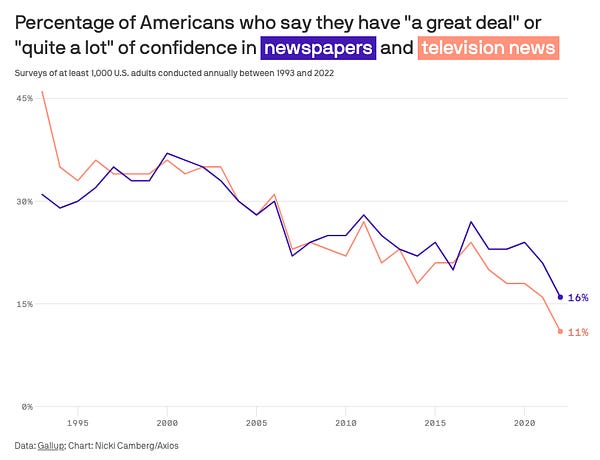 Chirag Rao @Chir_Rao @balajis Who/what then will be the new mainstream media?Should DAOs Pay Delegates?Author: Raphael Spannocchi Delegates are now becoming critical stakeholders within DAOs. Paying delegates leads to high-quality participation, helps attract talent from traditional web2 companies, and protects risk and downside for the DAOs. As the decision-makers within DAOs, delegate work has become a full-time job. The DAO needs to pay its delegates to get good governance, but too much or too little pay can create problems. To figure out the right amount, delegates' compensation is often tied to activity metrics like voting and communication. However, this can create a problem if the delegates start gaming the metrics to get paid more. To avoid this, the DAO often only pays delegates that the community has vetted. Not paying delegates means forfeiting access to top talent and specialized organizations, who'll move to greener pastures. Paying delegates presents a decent set of game theoretical challenges to set the incentives right. The Uncanny Valley of CryptoAuthor: Samantha Marin An uncanny valley is a phenomenon most often compared to the unsettling feeling people may experience when looking at a life like android or very realistic CGI; the films Ex Machina and Beowulf come to mind. What we see appears very convincing but something feels out of place, missing, incomplete, or just not quite right; almost like an instinct. DAOs and the work we do in them is so far removed from the physical world we often have to describe everything crypto related in terms of metaphors, creating a gap between what we are building in this metaverse and the real world. What are we building, why are we building, and how can we bridge this divide? Ten impressions from FWB Fest 22Author: Yancey Strickler Yancey Strickler shares some of his takeaways from a recent Friends with Benefits gathering in the mountain tops of Idyllwild, California. Meshing the online and IRL can have surprising results and he found this event to be like a destination wedding with a temporary family, where attendees could safely present themselves and their pseudonymous characters. Beyond the event’s happenings, Yancey found himself contemplating deeper thoughts around what it means to be a DAO member. He joined the group by purchasing the necessary number of tokens and has attended two events. However, Strickler’s never engaged with the community on Discord and has no intention of participating in governance at all. He was drawn to FWB through shared values and an admiration for the direction the more eager participants were taking it. This is a contrast to the idea that DAOs are supposed to be about 100% collective collaboration and such the structure starts to resemble society’s incumbent hierarchies. These findings inspire many existential questions for DAOs but underlying those is the idea that, if the groups continue to produce environments focused on delivering meaningful cultural experiences, then they’ll maintain an audience. Platformless Quests: The Missing Piece of the Community EquationAuthor: Forefront The promise of tokenized communities is to build platformless networks. The magic of a "platformless community" stops with the collectively held key, the assets. A truly platformless membership must be able to aggregate information from across all of the actions that I take to inform how I can interact with communities I have access to. Platformless communities require a world of platformless quests. Token-gating enables community portability – what we need is community composability. For example, Layer3 takes an approach, enabling communities to create bounties and contests on the platform that can then be rewarded with XP or other tokens. Guild is aggregating these experiences, bringing together information from Twitter, Github, Google Docs, and more platforms. Every piece of this equation needs to be platformless, composable, and open. Ecosystem Takes
Introduction to Gitcoin PassportAuthor: Team Gitcoin 🔑 Insights: Having access to a self sovereign digital identity is a public good. Gitcoin after many rounds of funding eventually faced the problem of Sybil attacks; where grant seekers began abusing the quadratic voting system to make it appear like more individuals were donating to a project when in reality it was far fewer. To prevent this they implemented a tiered proof of humanity system where donors would validate their unique humanity by using several ID providers, some Web2 and some Web3. Now they are opening up their solution to other platforms who also require Sybil resistance in the form of a on-stop-shop, Web3 standardized, passport.
Designing Governance TokensAuthor: Alana Levin 🔑 Insights: Many projects in web3 are adopting a one-size-fits-all governance model, when in reality the token designs should be much more context-driven. There are a set of critical decision points teams must align on, and how each team chooses should impact the acquisition profile and scope of influence associated with their governance token. When designing governance token, teams should ask themselves below 3 questions:
Top 9 Challenges of DAO Unit SuccessAuthor: RnDAO 🔑 Insights: RnDAO is an innovation center with a mission to empower human collaboration. In partnership with Sobol, they’ve published nine key challenges facing DAO Units (or SubDAOs). By studying these potential headwinds, groups can arrive at more effective cooperation, but in such complex systems, any solutions are likely to combine multiple approaches to enable better organization.
A POLITICAL HISTORY OF DAOSAuthor: Kelsie Nabben 🔑 Insights: The Cypherpunks Mailing List was started in 1992 by three Silicon Valley misfits interested in digital privacy. The Cypherpunks were united by a belief that people should be able to live free from state interference in private matters and a conviction that this freedom could be achieved through the use of digital encryption technology that allowed people to communicate without being surveilled.
DAO Spotlight: DomainDAOAuthor: DomainDAO DomainDAO secured 360+ ETH through crowdfunding to build the domain space of the future DomainDAO, is a new community-driven initiative to bid on the .dao top-level domain from ICANN. Currently in Phase II crowdfunding on Juicebox Protocol, the current round will end next week. DomainDAO has been the #1 trending project on Juicebox for almost two months, raising over 360 ETH, which is a fantastic achievement given current market conditions. Key participants include DAOs, individual DAO members, and renowned crypto venture capitals. The monopoly DomainDAO aims to disrupt Many prominent domains such as .io and .finance are controlled by private companies or government-backed agencies, and DomainDAO wants to disrupt that with decentralization. Founded by web3 professionals and enthusiasts, DomainDAO wants to decentralize the governance of top-level domains (TLD), starting by proposing and bidding on a new top-level domain - .dao under ICANN's regulatory framework. More DAOs are being created than ever before and might soon become the mainstream structure for organization governance. Finding an identity for DAOs – from bankless.community to bankless.dao DomainDAO wants to think ahead on how DAOs will identify themselves in the digital space with the traditional TLD setup, hence its mission of owning .dao for DAOs, by a DAO. Upon successful application, DAOs would be able to show off their DAO entities with their domains. bankless.community would become bankless.dao, and that applies to all other DAOs. The roadmap ahead – building a DAO ecosystem Claiming and building the .dao domain is just the first step. There are many other things on the roadmap, which include, but are not limited to, adding more TLDs, developing infrastructure for DAOs, and promoting DAO culture globally. DomainDAO has recruited more than twenty DAOs to form a tight-knit community, including popular ones like Cult DAO, City DAO, PleasrDAO, etc. All founding partners will receive exclusive DomainDAO NFTs as proof to reserve their preferred .dao secondary domains with $DOMAIN before DomainDAO successfully bid the TLD. These partnerships have proven there is strong demand for the .dao TLD, and DomainDAO plans to build a DAO ecosystem that encourages, supports, and fosters the development of DAOs. Only 1 week left to contribute to DomainDAO There are multiple ways one can contribute and steer this revolution.
 Get Plugged InEvent HighlightsSmartCon 2022 — Hosted by ChainlinkThere will be two full days of keynotes, panels, developer workshops, and AMAs featuring leading projects and speakers from across the blockchain ecosystem. You’ll get insight into the latest Web3 developments directly from researchers, developers, and founders at the forefront of smart contract innovation. This event will be held live in New York City, New York and virtually from September 28-29. 🧳 Job OpportunitiesGet a job in crypto! Do you like solving hard problems, care about building more efficient markets for everybody, and want to work at the frontier of decentralized finance? Rook is looking for full time contributors, with salaries ranging from $169,000-$722,000. There are positions ranging from engineering, recruiting, product marketing, copywriting, and design. Sound interesting? Sign up for our referral program and go full-time DAO.
If you liked this post from BanklessDAO, why not share it?
|
Older messages
Metaverse Art Week 2022 | Decentralized Arts #52
Tuesday, August 23, 2022
Dear Bankless Nation, Decentralized Arts (DA) celebrates with this issue its first anniversary. In this year we have brought you a myriad of stories around non-fungible tokens (NFTs) and the metaverse.
When Too Much Is Not Enough | BanklessDAO Weekly Rollup
Monday, August 22, 2022
Catch Up With What Happened This Week in BanklessDAO
The AMM Edition (Part II) | DeFi Download
Thursday, August 18, 2022
Your Trusted Source for 101s, Project Announcements, and Tokenomics Tutorials.
Jose Delbo: From Comic Artist to NFT Comic Creator | Decentralized Arts
Tuesday, August 16, 2022
Dear Bankless Nation, Congratulations to BanklessDAO for the start of Season 5! The DAO has changed a lot since its inception. Many of the initial contributors have stepped down from core roles over
A Tale of Two Markets | BanklessDAO Weekly Rollup
Saturday, August 13, 2022
Catch Up With What Happened This Week in BanklessDAO
You Might Also Like
Trump’s crypto reserve faces backlash over ADA and XRP inclusion
Monday, March 3, 2025
Ripple and Cardano leaders embrace Trump's multichain approach despite criticism for altcoin inclusion. ͏ ͏ ͏ ͏ ͏ ͏ ͏ ͏ ͏ ͏ ͏ ͏ ͏ ͏ ͏ ͏ ͏ ͏ ͏ ͏ ͏ ͏ ͏ ͏ ͏ ͏ ͏ ͏ ͏ ͏ ͏ ͏ ͏ ͏ ͏ ͏ ͏ ͏ ͏ ͏ ͏ ͏ ͏ ͏ ͏ ͏ ͏
📈 Bitcoin dominance reached a 4-year high of 62%; Trump announced a strategic crypto reserve with BTC, ETH, XRP, …
Monday, March 3, 2025
Bitcoin dominance reached a 4-year high of 62%; Cronos becomes the first blockchain to power crypto-to-debit transfers; Trump announced a strategic crypto reserve with BTC, ETH, XRP, SOL, and ADA ͏ ͏ ͏
White House Schedules First Ever Crypto Summit
Monday, March 3, 2025
March 3rd, 2025 Sign Up Your Weekly Update On All Things Crypto TL;DR White House Schedules First Ever Crypto Summit SEC Declares Meme Coins Are Not Securities Consensys Secures Victory In MetaMask
VC Monthly Report, February Sees 14% Growth in Funding Amount and Deal Count, Stablecoins and Payments Dominate In…
Monday, March 3, 2025
According to RootData statistics, there were 98 publicly disclosed crypto VC investment projects in February 2025, a 14% increase month-over-month (compared to 86 projects in January 2025) but a 35.1%
Bitcoin’s steep decline fueled by short-term holders
Sunday, March 2, 2025
High-frequency traders and day traders rile Bitcoin market as prices plummet. ͏ ͏ ͏ ͏ ͏ ͏ ͏ ͏ ͏ ͏ ͏ ͏ ͏ ͏ ͏ ͏ ͏ ͏ ͏ ͏ ͏ ͏ ͏ ͏ ͏ ͏ ͏ ͏ ͏ ͏ ͏ ͏ ͏ ͏ ͏ ͏ ͏ ͏ ͏ ͏ ͏ ͏ ͏ ͏ ͏ ͏ ͏ ͏ ͏ ͏ ͏ ͏ ͏ ͏ ͏ ͏ ͏ ͏ ͏ ͏ ͏ ͏
Asia's weekly TOP10 crypto news (Feb 24 to Mar 2)
Sunday, March 2, 2025
According to Coindesk, citing local news outlet Dawn, Pakistan is planning to establish a National Crypto Committee to formulate cryptocurrency policies. ͏ ͏ ͏ ͏ ͏ ͏ ͏ ͏ ͏ ͏ ͏ ͏ ͏ ͏ ͏ ͏ ͏ ͏ ͏ ͏ ͏ ͏ ͏ ͏
On ICOs, NFTs, and Memecoins
Sunday, March 2, 2025
CRYPTODAY 143 ͏ ͏ ͏ ͏ ͏ ͏ ͏ ͏ ͏ ͏ ͏ ͏ ͏ ͏ ͏ ͏ ͏ ͏ ͏ ͏ ͏ ͏ ͏ ͏ ͏ ͏ ͏ ͏ ͏ ͏ ͏ ͏ ͏ ͏ ͏ ͏ ͏ ͏ ͏ ͏ ͏ ͏ ͏ ͏ ͏ ͏ ͏ ͏ ͏ ͏ ͏ ͏ ͏ ͏ ͏ ͏ ͏ ͏ ͏ ͏ ͏ ͏ ͏ ͏ ͏ ͏ ͏ ͏ ͏ ͏ ͏ ͏ ͏ ͏ ͏ ͏ ͏ ͏ ͏ ͏ ͏ ͏ ͏ ͏ ͏ ͏ ͏ ͏ ͏ ͏ ͏ ͏ ͏ ͏
StanChart warns of further downside for Bitcoin over the weekend akin to August 2024
Saturday, March 1, 2025
Standard Chartered sees parallels to past Bitcoin sell-offs amid volatile weekend projections. ͏ ͏ ͏ ͏ ͏ ͏ ͏ ͏ ͏ ͏ ͏ ͏ ͏ ͏ ͏ ͏ ͏ ͏ ͏ ͏ ͏ ͏ ͏ ͏ ͏ ͏ ͏ ͏ ͏ ͏ ͏ ͏ ͏ ͏ ͏ ͏ ͏ ͏ ͏ ͏ ͏ ͏ ͏ ͏ ͏ ͏ ͏ ͏ ͏ ͏ ͏ ͏ ͏
Weekly Project Updates: Babylon Launches Airdrop Registration, Berachain Initiates Phase One of Governance, and Me…
Saturday, March 1, 2025
In the recent theft incident of Bybit, hackers laundered money by exchanging ETH for BTC through THORChain, bringing huge trading volume and fees to THORChain. ͏ ͏ ͏ ͏ ͏ ͏ ͏ ͏ ͏ ͏ ͏ ͏ ͏ ͏ ͏ ͏ ͏ ͏ ͏ ͏ ͏
Bitcoin pullback could be set up for $370k bull run price target
Friday, February 28, 2025
Bitcoin's 27% slide raises prospects for rebound, aligns with historical cycle patterns. ͏ ͏ ͏ ͏ ͏ ͏ ͏ ͏ ͏ ͏ ͏ ͏ ͏ ͏ ͏ ͏ ͏ ͏ ͏ ͏ ͏ ͏ ͏ ͏ ͏ ͏ ͏ ͏ ͏ ͏ ͏ ͏ ͏ ͏ ͏ ͏ ͏ ͏ ͏ ͏ ͏ ͏ ͏ ͏ ͏ ͏ ͏ ͏ ͏ ͏ ͏ ͏ ͏ ͏
